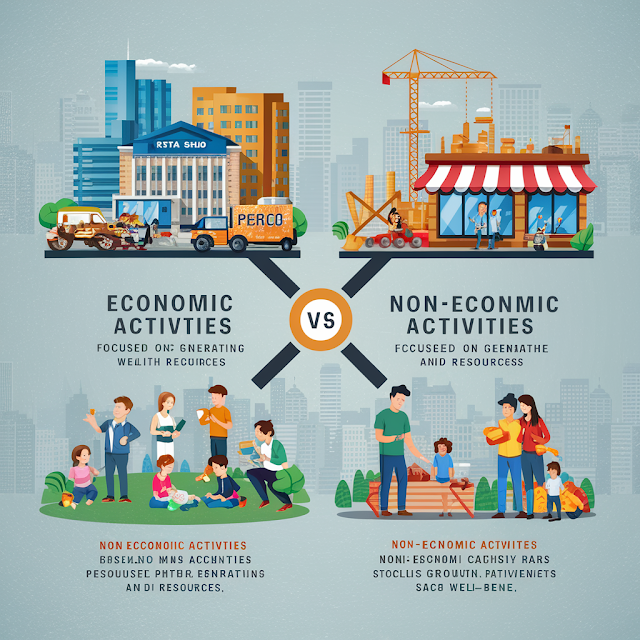What is The Difference Between Economic Activities And Non Economic ?
What is The Difference Between Economic Activities And Non Economic ?
 |
| The Difference Between Economic Activities And Non Economic |
Economic activities and non-economic activities differ in their primary objectives and outcomes:
1. Economic Activities:
Economic activities are undertaken with the primary goal of generating income or wealth.
These activities involve the production, distribution, and consumption of goods and services for monetary gain.
Participants in economic activities aim to maximize profits, increase productivity, and contribute to economic growth.
Examples include manufacturing goods, providing services, trading goods, investing in financial markets, and so on.
2. Non-economic Activities:
Non-economic activities are not primarily motivated by monetary gain.
They are undertaken for personal satisfaction, social welfare, or cultural reasons.
These activities may include volunteering, household chores, recreational pursuits, hobbies, and leisure activities.
While they may not directly contribute to GDP or economic growth, they are essential for personal development, social cohesion, and overall well-being.
In summary, economic activities are focused on generating income and contributing to economic growth, while non-economic activities are more about personal fulfillment, social well-being, and cultural enrichment.
Here are some additional points of differentiation between economic and non-economic activities:
1. Motivation:
Economic activities are primarily motivated by financial incentives, such as profit, wages, or investment returns.
Non-economic activities are driven by personal interests, social values, or altruistic motives rather than financial gain.
2. Measurement:
Economic activities can be measured in monetary terms, allowing for quantification of their contribution to GDP and economic indicators.
Non-economic activities are often challenging to measure in monetary terms because their value is subjective and not easily quantifiable. However, they contribute to societal well-being and quality of life.
3. Market Involvement:
Economic activities typically involve transactions in markets where goods and services are exchanged for money.
Non-economic activities may or may not involve market transactions. For example, volunteering at a community center or spending time with family members does not involve monetary exchange.
4. Resource Allocation:
Economic activities involve the allocation of scarce resources (such as labor, capital, and natural resources) to produce goods and services efficiently.
Non-economic activities may also require resources but are often less concerned with efficiency or profitability. Instead, they prioritize personal or social fulfillment.
5. Economic Impact:
Economic activities have a direct impact on economic indicators such as GDP, employment rates, inflation, and trade balances.
Non-economic activities, while not directly contributing to economic metrics, can indirectly influence factors like social capital, mental health, and community cohesion, which in turn can affect economic outcomes.
Understanding the distinction between economic and non-economic activities provides insight into the multifaceted nature of human behavior and the diverse motivations behind different types of actions within society.
Economic activities revolve around the production, distribution, and consumption of goods and services with the primary aim of generating income or wealth. They encompass a wide range of activities, from manufacturing and trade to financial investments and services. For instance, when a company produces and sells smartphones, it engages in economic activity aimed at earning profits.
On the other hand, non-economic activities are driven by motives other than monetary gain. These activities are essential for personal development, social cohesion, and cultural enrichment. They include things like volunteering, engaging in hobbies, spending time with family, and pursuing artistic or recreational interests. While they may not directly contribute to the economy in terms of GDP, they play a crucial role in enhancing overall well-being and quality of life.